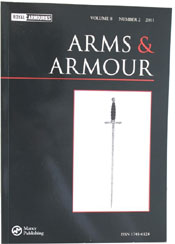
Arms & Armour Journal, Vol 8, No 2 (2012)
'Logistics and Supply in Medieval and Renaissance Armies'
by Lt-Gen Jonathon Riley CB, DSO, PHD, MA

The following, is an extract from a paper presented at the Royal Armouries Conference on the Wars of the Roses, held at the Tower of London on 26 March 2011.
Introduction
Military doctrine defines logistics as ‘the science of planning and carrying out the movement and maintenance of forces’. Logistics is the practical art of moving armies and providing for the successive provision of support. It is a continuous operation. For our purposes here today it may be taken to be synonymous with the business of sustainment - that is, the actual process of maintaining an army during operations. Inseparable from it is administration, which includes record keeping, discipline, medical provision and pay. In this paper, however, I shall be concentrating only on the business of sustainment in order to increase the understanding of the fact that it is one thing for a commander to order an army to a place, but quite another to get it there and then keep it there.
Logistics, because it deals in resources, be those human, animal or materiel, is one of the drivers that military commanders and their staffs must always consider when planning. During the period we are discussing, the staff as such did not exist - but there were officials such as the Masters of the Armouries and the Ordnance with their own officers, who fulfilled these functions.
Logistic planning has to be undertaken at every level: strategic, operational, and tactical. It is complicated greatly by expeditionary warfare on hostile territory. The medieval commander, like his modern counterpart, had therefore to ask himself a number of questions: what supplies would be available or could be expected? What was the available transport by land, river or sea? What were the length, security and nature of the line of communication? What was the available manpower for the campaign and how much time would be needed to bring up replacements? What medical arrangements should be made for dealing with wounds and diseases? In short, how was the army to be fed, clothed, armed, munitioned, resupplied, reinforced and cared for? If he did not do this, his force would rapidly cease to be effective.
There are four timeless factors governing the development of any logistic plan and system: these are demand, distance, duration and destination. By planning carefully according to these factors, operations can be kept within reach of adequate sustainment. Beyond this reach, an army will receive inadequate supply and its operations will culminate rapidly. Since the basic functioning of human and animal bodies has not changed since the medieval period, in terms of how much they need to eat and drink; and how susceptible they are to wounds and diseases, these four factors can still form the basis of our analysis of renaissance logistics today. This helps greatly in extrapolating backwards to a time when the contemporary sources are, to say the least, sparse. Because of this, I have several times had to go to sixteenth century or later accounts - where human or animal physiognomy is concerned, or where the technologies are similar - to be able to make reasonable calculations: hence the title of this paper...
Jonathon Riley
Copyright © Royal Armouries